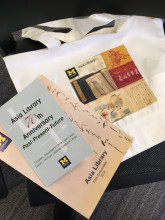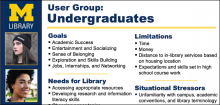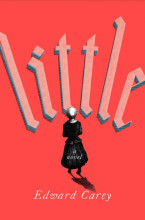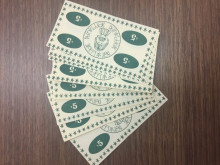Scott David Witmer
Library Blogs
Showing 1 - 10 of 14 items
Results
for Date: December 2018

A brief photo tour of the Digital Preservation Unit's Pop-Up Digital Archiving event for World Digital Preservation Day 2018.

Asia Library looks back on its December 6 anniversary event.
•
In the second post of the Social Class in the Workplace Series, Shannon Moreno shares a personal essay, reflecting on the ways that social class impact her daily work and the way she moves through the library at large.

The first post ("Personas: A Classic User Experience Design Technique") in this 2-part series described what personas are and, generally, how to create them. I closed with some cautions about ways personas might come out less than helpful – creating flat, overloaded, or fake (unresearched) personas. The second post presents our persona development for a specific website project.

This brilliantly-written historical novel tells the story of Anne Marie Grosholtz, who became the wax sculptor Madame Tussaud, in her own unique voice. Orphaned at an early age, Marie learns the art of modeling body parts for anatomical study from a physician. Eventually she draws the attention of the royal family, and she tutors the sister of Louis XVI. Her business prospers in the tumultuous days of the French Revolution, but her association with the royal family leads to her imprisonment. Marie is a survivor, though, and, after losing many friends during the revolution, she eventually goes to London, where her famous museum was established.

As an intern in Digital Content and Collections (DCC), I have been working with various older digital collections and projects, to address any issues that have come up since their creation. Each of these collections is unique in content and format, with digitization, description, and access processes designed within the context of grants, stakeholder goals, user needs, and technical capacity. Most recently, I completed a project to ensure access to digitized materials from the Superiorland Library Cooperative (SLC) and through this project learned several lessons that are useful for me -- and anyone else working with older digitized materials -- to keep in mind for future projects with digital collections.

Our last Special Collections After Hours event of the semester is today! We'll be viewing and playing radical board games from the Joseph A. Labadie Collection. We're also happy to announce the winter term slate of open houses.

To help conclude our 10th anniversary celebrations, we wanted to highlight an online exhibit that we originally put together five years ago called CVGA Disassembled. It summarizes many of the different generations of game systems, and how they've evolved since they first became popular in the late 1970s and early 1980s. It also takes a look at how game systems have evolved on the inside, including several images of partially disassembled game systems in each game generation.

1. What brought you to the Shapiro Design Lab?
I was first introduced to the Shapiro Design Lab two years ago when the director, Justin Schell, served as my mentor for a U-M Library mini-grant project. Justin’s mentorship of our misfit group of wide-eyed, wanna-be social entrepreneurs was nothing short of pivotal to keeping our group together through our first pitch competition, Innovation in Action. In 2017, Justin told me that the next year he would be starting a graduate student residency program concentrating on video games and I have been lucky enough to be part of the Design Lab ever since.
I was first introduced to the Shapiro Design Lab two years ago when the director, Justin Schell, served as my mentor for a U-M Library mini-grant project. Justin’s mentorship of our misfit group of wide-eyed, wanna-be social entrepreneurs was nothing short of pivotal to keeping our group together through our first pitch competition, Innovation in Action. In 2017, Justin told me that the next year he would be starting a graduate student residency program concentrating on video games and I have been lucky enough to be part of the Design Lab ever since.
•
Machine learning is changing the world around us and it will continue to dramatically shape our future. Complex computer algorithms are slowly starting to define our interactions with vehicles, social media, and Netflix. That’s right, even the shows Netflix recommends for you are, in part, the result of a complex machine learning algorithm.
Despite the omnipresence of machine learning in the world around us, the mystique that surrounds these two words is palpable. Many people forfeit trying to understand how machine learning works upon reading the word algorithm. I, however, decided to delve into the topic through an online course. In an attempt to better understand just what is happening during a machine learning program, I completed the Lynda.com course, “Machine Learning and AI Foundations: Value Estimations,” taught by Adam Geitgey. Participating in the course left me believing that, although machine learning is a highly complex process, one does not need to understand exactly what is going on under the hood of the algorithm, so long as they can navigate the program.
Despite the omnipresence of machine learning in the world around us, the mystique that surrounds these two words is palpable. Many people forfeit trying to understand how machine learning works upon reading the word algorithm. I, however, decided to delve into the topic through an online course. In an attempt to better understand just what is happening during a machine learning program, I completed the Lynda.com course, “Machine Learning and AI Foundations: Value Estimations,” taught by Adam Geitgey. Participating in the course left me believing that, although machine learning is a highly complex process, one does not need to understand exactly what is going on under the hood of the algorithm, so long as they can navigate the program.